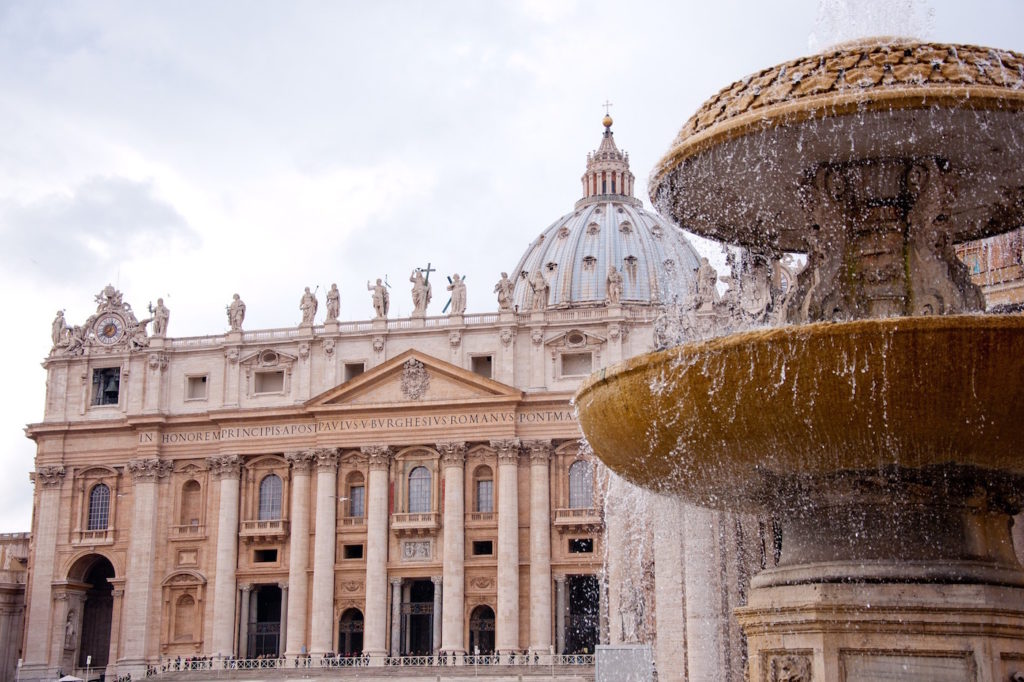On May 7, 2019, Pope Francis issued motu propio an Apostolic Letter, entitled Vos estis lux mundi (which means “You are the light of the world”). The letter sets forth a new set of accountability rules for Roman Catholic bishops who commit sexual abuse or cover up abuse by other clerics. There are a number of praiseworthy provisions in the new rules, but also some glaring problems and omissions.
The Catholic Church has been grappling with the problem of sexual abuse by its clerics and members of religious orders for decades. In the United States, the 2002 Dallas Charter accomplished much. The number of abuse cases involving post-2002 conduct is significantly lower than those involving pre-2002 conduct. Unfortunately, a series of events in 2018—from the revelations about Theodore McCarrick to the Pennsylvania grand jury report to Archbishop Vigano’s allegations of a papal cover-up—made clear that the Church’s accountability scheme still had serious problems.
In the wake of these disclosures, Boston Cardinal Seán O’Malley acknowledged that “when charges are brought regarding a bishop or a cardinal, a major gap still exists in the Church’s policies on sexual conduct and sexual abuse.” The Dallas Charter contained no mandatory rules governing misconduct by bishops. Instead, sexual abuse or coverups by bishops were subject only to secretive processes conducted by Vatican tribunals.
The new rules attempt to fill that gap.
Start your day with Public Discourse
Sign up and get our daily essays sent straight to your inbox.The Scope of the New Rules
The rules broadly apply to the Church hierarchy, including bishops, cardinals, and leaders of religious orders. They apply to both the Latin Church and the various Eastern Rite Churches in communion with the Pope.
The conduct to which the rules are addressed includes possession or distribution of child pornography, any sexual acts with a minor or vulnerable person (such as someone with limited physical or mental capacity), and “forcing someone, by violence or threat or through abuse of authority, to perform or submit to sexual acts.” Although many press reports claim that the new rules prohibit sexual conduct between a bishop and a priest or seminarian, such as the conduct of which McCarrick was accused, the rules in fact do not apply to consensual sexual relationships of any sort. This is a glaring omission. Instead, only coerced sex between a bishop and an adult—whether seminarian or not—is expressly forbidden.
Conduct of an Investigation
The core of the new rules is a variant of the Metropolitan model proposed by Cardinal Blase Cupich, Archbishop of Chicago. To understand this model, some definitions are necessary.
Each Roman Catholic diocese is headed by a bishop, who within his diocese “has all ordinary, proper and immediate power” (1983 Code § 381 § 1). Multiple dioceses in a geographical area are grouped into an ecclesiastical province, which is governed by a Metropolitan bishop, who is usually the archbishop of the province’s archdiocese. The bishops of the other dioceses within the province are known in canon law as suffragan bishops.
A Metropolitan’s powers are much less important today than they were centuries ago, when transport and communication speeds made appeals to the Vatican far more cumbersome than they are now. Nevertheless, canon law (1983 Code c. 436 § 1.1) continues to provide that a Metropolitan is “to exercise vigilance so that the faith and ecclesiastical discipline are observed carefully” within the suffragan dioceses “and to inform the Roman Pontiff of abuses, if there are any.” It is that grant of authority on which the new rules presumably rest.
Under the new rules, allegations against a suffragan bishop shall be referred to the Metropolitan of the relevant province and to the Vatican. Unless the report is “manifestly unfounded,” the Metropolitan is to request Vatican permission to conduct an investigation. If the Vatican approves an investigation, the Metropolitan is solely charged with conducting it. There is an extremely limited role for the laity, in that the Metropolitan may but need not choose qualified lay persons to assist the investigation. The result of the investigation is to be forwarded to the Vatican, which will decide what if any penalties to impose. In the event of a complaint against a Metropolitan, essentially the same process is followed, except that the investigation is conducted by the senior suffragan bishop for the province.
In a previous Public Discourse essay, I argued that the Metropolitan model is seriously flawed. As adopted, the new rules at least offer some transparency by requiring the Metropolitan to inform the person who reported the allegations of the result of the investigation. Concerns about the lack of transparency remain, however, because the rules do not ensure that either the allegations or the results of the investigation will be made known to either the victim or the civil authorities.
Most importantly, these rules leave the accountability process open to charges of cronyism and clericalism. The new system leaves the process in the hands of bishops and Vatican tribunals, who are precisely the authorities the laity and broader public trust least.
Protections for Whistleblowers
The new rules include important provisions requiring certain church leaders to blow the whistle on sexual abuse and providing protections for whistleblowers. In secular contexts, such as corporate compliance, whistleblowing has been acknowledged as an important part of the companies’ internal control and risk-management processes, and numerous federal statutes provide protection for whistleblowers.
The Dallas Charter contained no such protections for whistleblowers. Fortunately, the newly announced rules specifically forbid “prejudice, retaliation or discrimination as a consequence of having submitted a report.” In addition, the rules ban “actions or omissions intended to interfere with or avoid civil investigations or canonical investigations, whether administrative or penal, against a cleric or a religious.” Oddly, however, the new rules do not specify what penalties may be imposed on those who violate these prohibitions. Because the new rules apply to “delicts against the sixth commandment of the Decalogue,” Code of Canon Law Canon 1395 may apply, which authorizes “just penalties, not excluding dismissal from the clerical state if the case so warrants.”
The Dallas Charter called for dioceses to set up policies by which whistleblowers could report sexual abuse, but it left the decision whether to make such a report up to the conscience of the individual.
In contrast, corporate compliance policies increasingly make whistleblowing mandatory. This trend got a kickstart in 2002 when the federal Sarbanes-Oxley Act required the Securities and Exchange Commission to adopt rules for lawyers who appear and practice before the Commission. Under those rules, a lawyer working for a publicly held corporation who becomes aware of evidence of a material violation of securities law or breach of fiduciary duty by the company must report the evidence “up the ladder” to the company’s general counsel or CEO. If he fails to appropriately respond to the report, the lawyer must report the wrongdoing to the company’s audit committee.
Outside the legal profession, adopting a mandatory up-the-ladder reporting process applicable to all employees is increasingly recognized as an important corporate governance best practice. The National Council of Nonprofits has promulgated a sample whistleblower protection policy, under which it is “the responsibility of all board members, officers, employees and volunteers to report concerns about violations of [the organization’s] code of ethics or suspected violations of law or regulations that govern [the organization’s] operations.”
Mandatory Whistleblowing
The Church’s new rules include a mandatory whistleblowing provision. The rules require a priest or member of a religious order who “has notice of, or well-founded motives to believe that, one of the” types of sexual misconduct covered by the rules has been committed to report the alleged violations to the local bishop. If the allegation involves a bishop, however, the priest must report it to the pertinent Metropolitan and may send it “to the Holy See directly or through the Pontifical Representative.” The new rules do not require the priest to report to civil authorities, but they do provide that they shall “apply without prejudice to the rights and obligations established in each place by state laws, particularly those concerning any reporting obligations to the competent civil authorities.”
Some commentators argue that mandatory whistleblowing rules like this are necessary both because of the limitations of voluntary whistleblowing and the benefits of a mandatory program. Voluntary whistleblower programs—even when supplemented by protections for whistleblowers—do not eliminate retaliation, especially subtle forms such as social stigmatization. In addition, voluntary whistleblowing programs often lack mechanisms to ensure that the person to whom the report is made conducts an adequate investigation and undertakes appropriate remedial measures.
Mandatory whistleblowing programs contemplate some form of sanction for employees who fail to report misconduct to their superiors. By thus enhancing the incentives to report misconduct, such programs can benefit both the organization and society at large. In particular, they enable the organization to intervene at an earlier stage, possibly reducing the impact of the wrongdoing. They may also deter misconduct in the first place, by increasing the probability that misconduct will be reported.
On the other hand, mandatory whistleblowing also has important costs. It can erode trust within the organization, thereby undermining a critical social lubricant that promotes organizational efficiency. Whistleblowing also can weaken hierarchical structures by encouraging employees to challenge authority. All of this tends to reduce organizational efficiency and competence by encouraging mutual suspicion, discouraging organizational loyalty, and lowering morale.
On balance, however, benefits of the new rules likely outweigh their costs. Priests and religious will often be in the best position to know when their colleagues or superiors are engaged in sexual abuse and, moreover, are directly adversely affected by abuse. As former Catholic Rod Dreher, who left the Church over the sex abuse scandal, observes:
Aside from actual victims of abusive priests and the bishops who covered up for them, parish priests are the ones who suffer the most from this kind of corruption. They often know what’s going on in the upper reaches of the Church’s administration, but feel that they can’t say anything. Many also fear that their people—the laity—believe that they are complicit in the corruption, even though they aren’t.
Mandating that clerics report misconduct by colleagues or superiors thus leverages the knowledge of those best positioned to know of such misconduct in a way that is essential to an effective compliance program.
No Mandatory Reporting to Civil Authorities
While some critics may complain about the costs of mandatory whistleblowing, more critics are likely to go in the other direction and complain about the failure to mandate reporting to civil authorities. In the United States, over half of the states now require clergy to report suspected child abuse. As we saw above, in such states, the Vatican’s new rules permit a cleric to comply with such legal requirements. In the other states and many countries, however, there are no such requirements.
Requiring clerics to report sexual abuse to civil authorities has several advantages. It would increase transparency, by exposing allegations to scrutiny by public officials. It would prevent bishops and other church leaders from covering up allegations. It would help deter priestly and episcopal misconduct by exposing abusers to criminal and civil liability.
The Vatican reportedly was concerned that some jurisdictions may not allow clerics to report abuse to local authorities. If so, however, the Vatican could have solved that problem by making reporting to civil authorities mandatory except in jurisdictions where the law expressly proscribes doing so. The failure to do so will be perceived as a major gap.
A Step in the Right Direction
The sexual abuse scandal forced the Catholic Church to grapple with legitimate and deeply rooted constraints. In the Catholic faith, the roles and powers of bishops prescribed by canon law differ fundamentally from the roles and powers of civil authorities as established by secular law.
The Church teaches that, before ascending to heaven, Christ appointed the apostles as the shepherds of His flock. In turn, the apostles appointed bishops to succeed them as the shepherds of Christ’s flock. Today, by virtue of apostolic succession, all bishops are believed to be part of an unbroken line of succession going back to the original disciples. Even the Pope stands in that line as successor of St. Peter as Bishop of Rome. The role and powers of the bishops thus are deeply embedded in the basic ecclesiology of the Church. Changing those powers thus requires not just a change in canon law, but potentially changes in the foundational doctrines of a church for which continuity of doctrine is a central claim.
The Church also has legitimate concerns about what some call “creeping Protestantism.” Proposals for greater lay involvement and for empowering national conferences have been widely criticized within the Church, including by some lay leaders, as leading towards an ecclesiology that is more Protestant than Catholic in nature.
At the end of the day, however, these concerns pale in comparison to Christ’s teaching that “Whoever causes one of these little ones who believe in me to sin, it would be better for him to have a great millstone hung around his neck and to be drowned in the depths of the sea” (Matt 18:6). The Church must protect children and vulnerable adults from abuse.
The new rules are a step in the right direction, but they still have significant gaps and problems. The big question going forward will be the extent to which national conferences, such as the USCCB, will be allowed to expand and enhance the new rules.
The USCCB meets next month. The eyes of the faithful will be on them.














